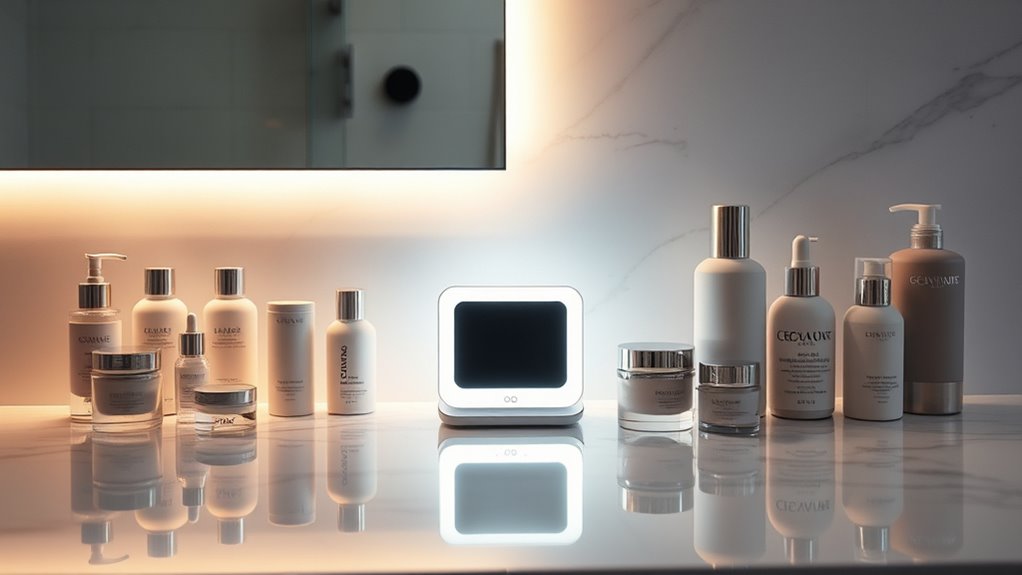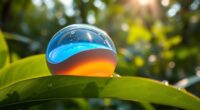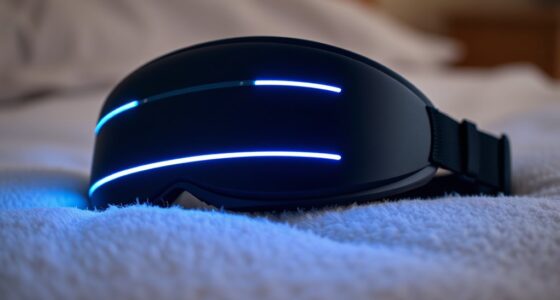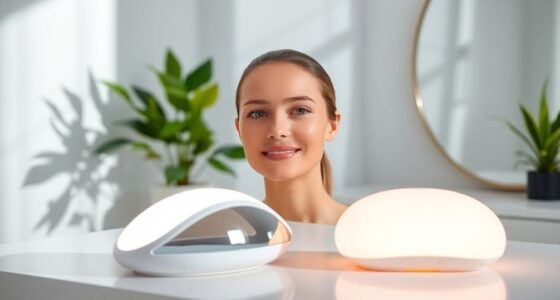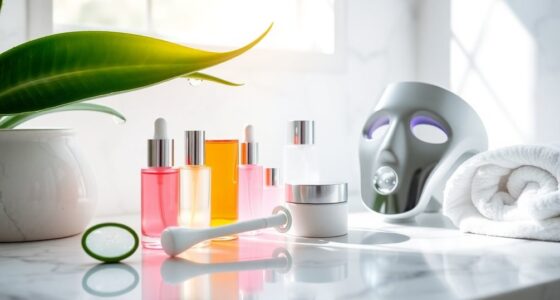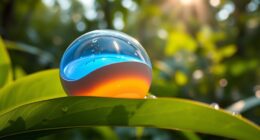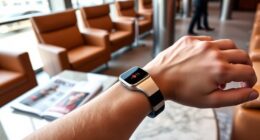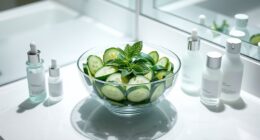A weekly skin-cycling plan with LED therapy involves alternating treatments to optimize skin health and prevent over-stimulation. Start with gentle cleansing, then use red LED on day 1 to boost collagen, followed by moisturizing. On day 2, exfoliate and rest your skin. Incorporate blue LED on day 4 to target bacteria and inflammation, then rest again. Maintain hydration, sun protection, and use nourishing products to support recovery. Continuing this routine can help you achieve clearer, healthier skin and learn how to customize your approach.
Key Takeaways
- Alternate red and blue LED light therapy on designated days to target collagen production and bacteria, respectively.
- Incorporate gentle cleansing, exfoliation, and hydrating moisturizers in a structured weekly schedule.
- Schedule rest days without active treatments to promote skin recovery and prevent over-stimulation.
- Follow LED sessions with soothing and nourishing products to support skin repair and reduce irritation.
- Maintain consistency, sun protection, and healthy habits for optimal, lasting skin-cycling results.
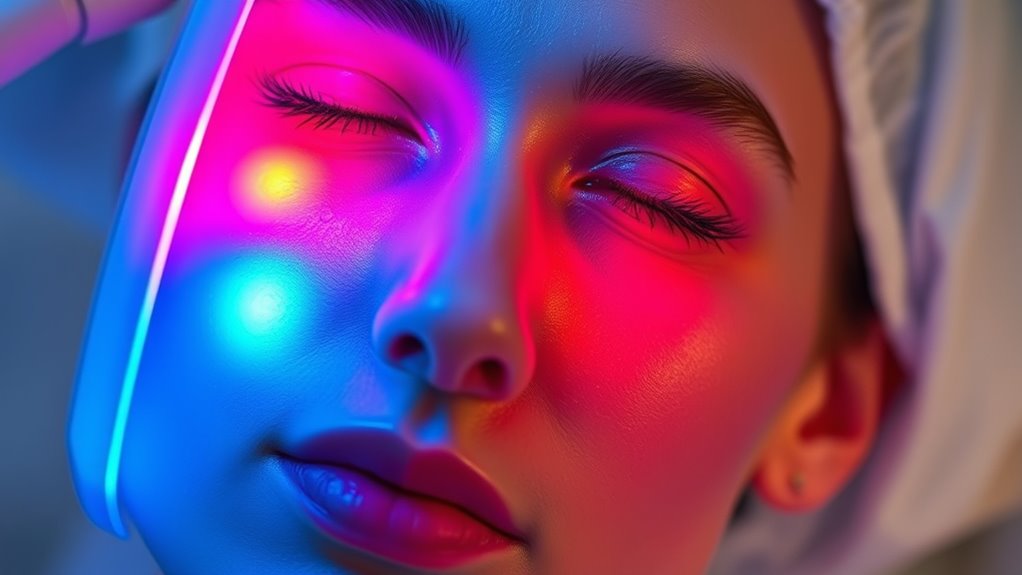
Have you ever wondered how to optimize your skincare routine for better results? If you’re exploring new ways to enhance your skin’s health, skin-cycling with LED therapy could be just what you need. This approach combines the benefits of targeted skincare with the power of LED light therapy, creating a structured weekly plan that maximizes effectiveness while giving your skin time to recover. The idea is simple: alternate between different treatments on specific days, so your skin gets the right stimulation without overdoing it.
Start your week with a gentle cleansing routine to remove dirt, oil, and makeup. This prepares your skin to better absorb treatments. On the first day of your skin-cycling plan, use LED therapy to stimulate cellular activity. Red LED light, in particular, promotes collagen production and reduces inflammation, helping your skin look firmer and more youthful. Follow this with a hydrating moisturizer to lock in moisture and support skin healing. This combination sets the stage for your skin to respond positively to subsequent treatments.
Begin your skin cycle with gentle cleansing and red LED therapy to boost collagen and reduce inflammation.
On the second day, focus on exfoliation. Use a gentle chemical exfoliant or enzyme mask to slough off dead skin cells. This step is essential because it clears the way for light therapy and other active ingredients to penetrate deeper. After exfoliating, avoid harsh scrubbing, and stick to soothing, nourishing products. The goal is to keep your skin calm and resilient, preventing irritation. Incorporating proper lifestyle habits such as adequate sleep and balanced nutrition can further enhance your skin’s recovery and overall health.
The third day involves a rest or recovery day. Skip active treatments and give your skin a break. Use a hydrating serum or facial oil if needed, but avoid strong acids or retinoids. This pause prevents over-stimulation and allows your skin to recover from the previous days’ treatments. Rest days are indispensable—they reduce the risk of irritation and help maintain the skin’s natural barrier function.
On the fourth day, return to LED therapy, but this time, incorporate blue LED light. Blue light targets bacteria that cause breakouts and helps reduce inflammation, making it ideal if you’re prone to acne. Follow up with a calming moisturizer to soothe your skin. Over the next few days, alternate between red and blue LED sessions, depending on your skin’s needs.
Throughout the week, maintain consistent sun protection and hydration. Your skin needs shielding from UV rays, especially when using active treatments and LED therapy. Ending your week with a nourishing mask or serum can enhance your skin’s repair process, leaving you with a clearer, more radiant complexion. Stick to this structured plan, and you’ll likely notice improvements in texture, tone, and overall skin health. Remember, patience and consistency are key to achieving lasting results with skin-cycling and LED therapy.
Frequently Asked Questions
Can Skin-Cycling With LED Treatment Be Combined With Other Skincare Routines?
Yes, you can combine skin-cycling with LED treatment with other skincare routines. Just make sure to introduce new products gradually to avoid irritation. Incorporate gentle cleansers and moisturizers, and use LED sessions as directed. Avoid harsh exfoliants or active ingredients like retinol on the same days as LED therapy. This way, you maximize benefits while keeping your skin safe and healthy.
How Long Does It Take to See Visible Results From LED Skin-Cycling?
Think of your skin like a garden; with consistent care, blooms appear. You’ll start seeing visible results from LED skin-cycling in about 4 to 6 weeks, but it varies based on your skin’s condition. Patience is key—stick to your routine, and you’ll notice improvements in clarity, texture, and brightness. Keep nurturing your skin regularly, and the glow will gradually reveal itself, like flowers opening after a gentle rain.
Are There Any Age Restrictions for Starting LED Skin-Cycling?
You can generally start LED skin-cycling at any age, but it’s best to consult with a dermatologist if you’re under 18 or have specific skin concerns. LED therapy is safe for most ages, yet individual skin sensitivities vary. If you’re pregnant, check with your doctor first. Always follow device instructions and start with shorter sessions to see how your skin reacts before increasing exposure.
What Are the Potential Side Effects of LED Skin-Cycling?
You might experience minor side effects like redness, dryness, or irritation after LED skin-cycling, especially if you have sensitive skin. These effects usually fade quickly and are manageable by adjusting your treatment or applying soothing moisturizers. Rarely, some may experience swelling or discomfort. Always follow the recommended guidelines, start with shorter sessions, and consult a dermatologist if you notice persistent or severe reactions.
How Do I Choose the Right LED Device for My Skin Type?
Like choosing a paintbrush for a masterpiece, selecting the right LED device depends on your skin type. If your skin is sensitive, look for devices with gentle, lower wavelengths like red or near-infrared. For acne-prone skin, blue light options work best. Always check the device’s specifications, consult reviews, and consider your skin’s unique needs. If unsure, consult a dermatologist to guide your choice.
Conclusion
Just like the moon’s gentle phases guide the tides, your skin can thrive with this thoughtful cycling. By embracing this weekly plan and harnessing LED therapy, you’re setting the stage for healthier, glowing skin—each step a whisper of nature’s rhythm. Remember, consistent care is your secret weapon, turning your skincare routine into a dance as timeless as the stars. Stay committed, and watch your skin bloom with the patience of a sunrise.
